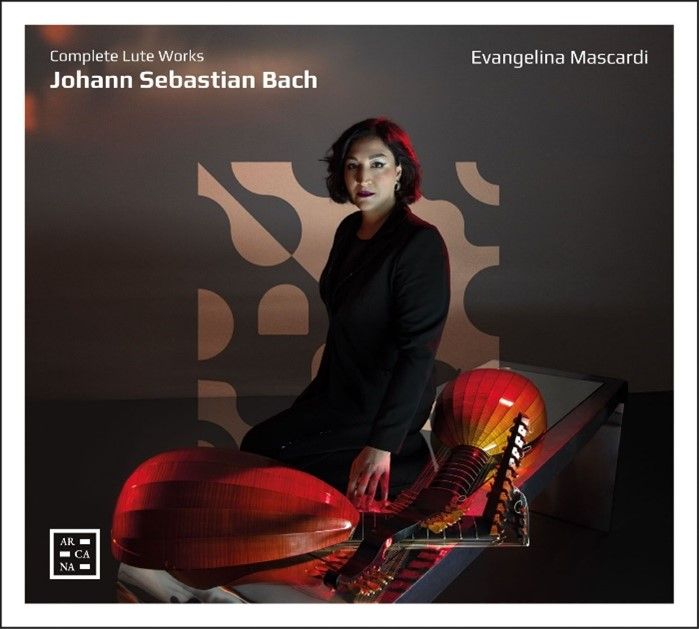Bach Complete Works for Lute
This is a magnificent set that should be showered with awards

Bach's works for lute offer one of the most beglected parts of his output. Evangeina Mascardi sets the record straight in thsi superb twofer. Bach used the lute in the first versions of both the St John and St Matthew Passions, plus the magnificent Trauer Ode, BWV 198. He was familiar with the work of German lutenists such as Silvius Leopold Weiss and Johann Christian Weyraich. We will meet Weyrauch later in this post, and we will feature Weiss in a future post.
You might well feel you know the Lute Suite, BWV 995, already - it is an arrangement of the Fifth Cello Suite, BWV 1011. Here's the first movement of the lute version:
While it is good to have a snippet, the Prelude is exactly that - it moves to the dance movements that comprise the remainder of the Suite. In fact the Suite confirms to the standard formal practice of the Baroque Suite of (Prelude) - Allemande - Courante - Sarabande - Gigue, with any additional dance movements userted between the Sarabande and the Gigue - in this case, a Gavotte with Gavotte II en Rondeaux.
The sheer beauty of the Allemande (from about 6 minutes) is remarkable, as is the crystelline "otherworld" of the Sarabande. It is fascinating to hear the famous Gavotte on lute, and how beautifully it is played here.
The key to the success of Mascardi's Bach is not just the beauty of sound, but he complete rhythmic control she exhibits. Rhythm and metre are the bedrock of successful Bach playing, and what pure joy it is to hear - eespecially when captured in Arcana's stunning recording.
Mascardi uses three different instruments during the course of the recording, all made bu Cezar Mateus and based on the work of the luthier Johann Christian Hoffmann (Leipzig, 1683-1750).
The Prelude, Fuga e Allegro in E flat, BWV 998 is remarkable for the genius of its Fugue. It dates from around 1740-45 and is designated as for lute or harpsichord. The restraint of Mascardi's performance, her awareness of linear workings, is not only magical but the epitome of historically informed performance awareness. The Fugue is over seven minutes long - towards its end is a chain of suspensions taht perfectly exemplifies Affektenlehre - the idea of a gesture representing an emotion, here a sighing gesture, The four-minute Allegro that concludes the piece cannothelp but raise a smile with its moto perpetuo so deliciously delivered:
The restrained Prelude in C-Minor, BWV 999 (here given its full title of Prelude in C moll pour la luth di Johann Sebastian Bach from German organist and composer Johann Peter Kellner's manuscript) is perfectly written for the instrument:
Written for the “Lautenwerk” (follow this link for more details and sound examples), a keyboard instrument with gut strings that sounded like a lute, the Suite, BWV 996, is an early work dating from between 1708 and 1717. It appears Bach later had what he knew as a ’Lautenclavicymbal’ (a Lautenwerk), from Leipzig 1740 by Zacharias Hildebrans, although BWV 996 appears to be more of a keyboard work at heart. Which doesn't stop Mascardi spinning her magic. The Allemande (starting at 3"09 below) is representative (note again the form: Preludio - Allemande - Courante - Sarabande - [inserted movement] Bourée - Giga):
There is little doubt that most people will recognise the opening of disc two: The Partita, BWV 1006a, a harmonisation from around 1740 of the Third Partita for Solo Violin in E-Major, BWV 1006 (I have appended a violin performance - Suunske Sato performing for the Netherland Bach Society's All of Bach, and beautifully filmed):
For me, it is Mascardi's “Loure” (the second movement) that is truly touching (from around 4"38 in her video above), but note also how the Menuets (the fourth movement, from 12"25) take on a depth not normally associated with this dance form.
Appearing on no less that 17 manuscripts, the Partita, BWV 997 is a mature work, from between 1738 and 1741. It includes a three-part Fugue Da Capo, a rarity in Bach's output although it appears twice in his lute output (BWV 998 also). The Fuga begins at 3"46 in the video below:
This magnificent set - which should be showered with awards - concludes with the Fuga del Signoro Bach, BWV 1000, an arrangement of the second movement of teh First Sonata for Solo Violin in G-Minor, BWV 1001. As the printed version of this (Johann Christian Weyrauch) takes liberties with Bach's original, adding several bars and with inconsistent usage of the lute's bass register, Mascardi has taken the initiative of taking Bach's original as a point of reference, with the Weyrauch as a starting point only:
Unhesitatingly recommended; a wonderful way to ecplore a lesser-known corner of Bach’s output.
